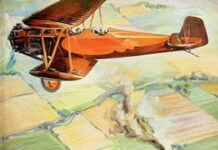1918 was a year of consolidation in military aircraft design, to the virtual exclusion of any civilian purpose. There was no lack of innovation on the part of aircraft manufacturers vying for their slice of the cake.
However, many designs failed to make it to these pages, because they were either flawed, overtaken by others, or victims of the Armistice that paused the conflict for 21 years.
First Person Clambers Aboard a Flying Aircraft (January 1918)
On a day in January 1918, a Bristol F2B pilot and his gunner-observer were caught up in a dogfight. The pilot put the plane in a steep dive to create space to maneuver. However, the force of the movement ejected the pilot-observer.
The hapless man fell several hundred feet through the air, and there were no parachutes in those days. And then in a way that’s not apparent, he and the aircraft ‘came together’. This enabled him to grasp the after fuselage, and crawl back into his cockpit apparently unharmed.
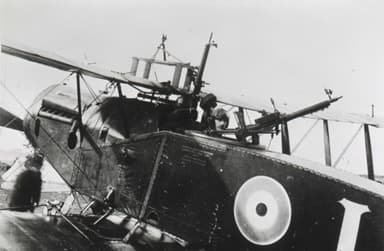
https://en.wikipedia.org/wiki/Bristol_F.2_Fighter#/media/File:Bristol_Fighter_on_field_of_Agincourt.jpg
The specification of the Bristol F.2B fighter was as follows:
- Length 26 ft, height 10 ft, wing span 39 ft, wing area 405 sq ft
- Empty weight 2,145 lb, max take off 3,243 lb, pilot and observer-gunner
- Rolls-Royce Falcon III V-12 liquid-cooled piston engine, 275 hp
- Max speed 123 mph, range 381 mi, ceiling 18,000 ft, 889 ft per minute
- One .303 inch forward-firing Vickers machine gun in upper fuselage
- One or two .303 inch Lewis guns in the rear cockpit, 240 lb bomb load
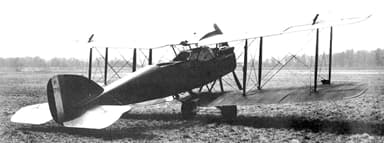
https://en.wikipedia.org/wiki/Bristol_F.2_Fighter#/media/File:Dayton_Wright_XB-1A_64158_P-179.jpg
Aircraft Prove Decisive Element in Ground Warfare (January 1918)
The Battle of Cambria was a trench-based struggle between well-matched troops, although Britain had the advantage of the first battle tank. At one stage the struggle seemed to be going her way. But then Germany launched a successful counter-attack.
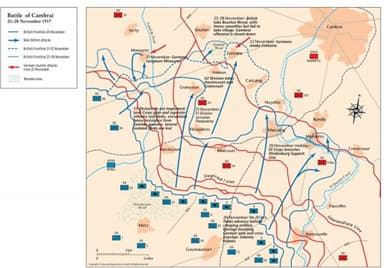
https://www.themaparchive.com/product/battle-of-cambrai-2028-november-1917/
Allied forces were alarmed this achievement could mean Germany might eventually triumph. A British Army inquiry revealed mass-use of close air support turned the battle in favor of the Central forces. It found the Allies felt helpless and became demoralized, allowing a successful German counter maneuver.
Heavy Bombers Continue to Demoralize London (Jan – Feb 1918
Germany continued to fight a psychological battle with its heavy bombers over the skies of London, despite the fact a ground invasion would be a non-starter. Its Gotha Grossflugzeug and Riesenflugzeug bombers struck fear in the English population who were largely helpless to respond.
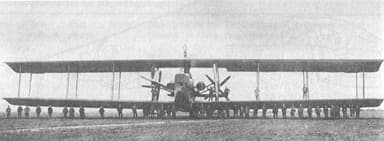
https://en.wikipedia.org/wiki/Riesenflugzeug#/media/File:Riesenflugzeug_Siemens_Schuckert_VIII_1918.jpg
British fighter pilots had small successes damaging, and even bringing down a few German bombers. However, the majority attacking bombers returned home safely, in one case after dropping a 1,000 pound bomb. Contemporary observers believed British pilots underestimated the bombers’ size, and fired at them from too great a range thinking they were closer to them.
Link to Image
First Successful Flight of Unmanned Powered Aircraft (March 1918)
The high loss of pilots over the battlefields of Europe was taking its toll, not the least on the morale of the public back home. On March 16, 1918 the United States responded with the first powered, un-manned heavier-than-air craft. The Curtiss-Sperry Flying Bomb was to become the precursor of modern unmanned aerial vehicles.
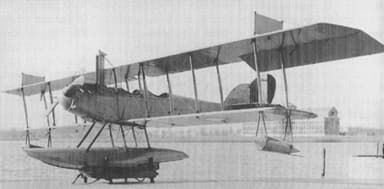
https://en.wikipedia.org/wiki/File:Curtiss_N-9H_on_ramp_c1918.jpg
The Curtiss N-9 was a military trainer in use by the United States Navy. Several were handed over to the Sperry Gyroscope Company for reconfiguration as the Hewitt-Sperry Automatic Airplane in 1916.
The founder, Elmer Sperry had worked on gyroscopes for naval use since 1896. However, his current interest lay in radio control, and automatic stabilisation for which his gyroscopes would form the basis.
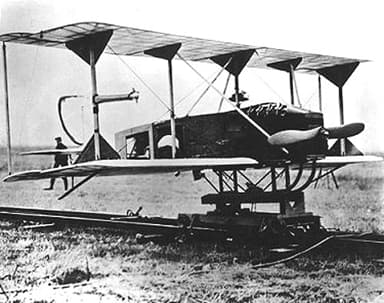
https://en.wikipedia.org/wiki/File:Hewitt-Sperry_Automatic_Airplane_1918.jpg
By 1916, Elmer Sperry and radio-specialist Peter Hewitt had assembled a control unit comprising a gyroscopic stabilizer, a directive gyroscope, and an aneroid barometer to regulate height. The kit also included servo-motors to control rudders and ailerons, and a device for distance gearing.
The U.S. government included the project in its war preparation, after it entered the First World War. In May 1917, it agreed to install the Sperry-Hewitt system in five (later seven) Curtiss N-9 seaplanes. But the developers were to discover the challenge had only begun.
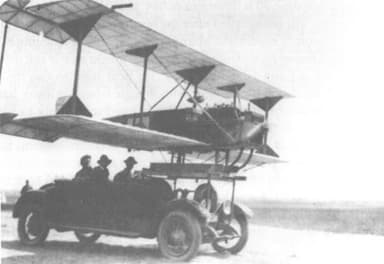
http://www.designation-systems.info/dusrm/app4/sperry-fb.html
Several unsuccessful launches followed, including sliding down a long wire and using a catapult energised by a three-ton weight. Sperry and his assistant then mounted their unmanned aerial vehicle atop a Marmon automobile capable of a top speed of 80 miles per hour, so they could fine-tune their design in a live wind tunnel.
The team realized the automobile had potential as a mobile launching platform too. A Curtiss-Sperry Flying Bomb lifted off the Marmon automobile cleanly on March 6, 1918, and flew a stable flight for 1,000 yards. For the first time in history, an un-manned, heavier-than-air vehicle had flown in a controlled flight.
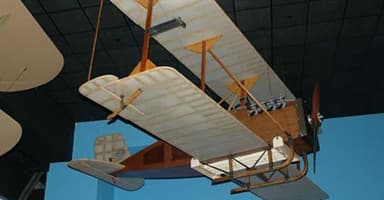
https://www.cradleofaviation.org/history/exhibits/exhibit-galleries/world_war_i/curtiss_sperry_aerial_torpedo.html
U.S. Naval Aircraft Factory Begins Production (March 1918)
Construction of the United States Naval Aircraft Factory began on August 10, 1917, heralding a facility that would play an important role in both world wars. It produced its first aircraft, a Curtiss H-16 228 days later, at League Island Navy Yard in Philadelphia, Pennsylvania.
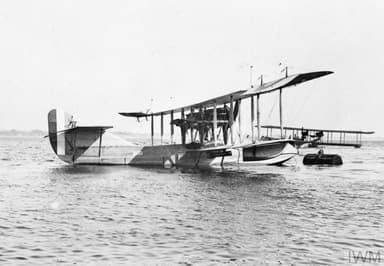
https://en.wikipedia.org/wiki/Curtiss_Model_H#/media/File:Curtiss_America_001.jpg
The specification of the Curtiss H-12 aircraft was as follows:
- Length 49.5 ft, height 19 ft, upper wingspan 104 ft, wing area 1,304 sq ft
- Empty weight 8,720 lb, gross weight 14,334 lb, crew four
- Two Liberty L-12A V-12 water-cooled piston engines, 400 hp each
- Max 90 mph, stall 57 mph, range 830 mi, ceiling 10,800 ft, 2,600 ft in 10 min
- Two machine guns, provision for uncertain weight of bombs

https://en.wikipedia.org/wiki/Felixstowe_F5L#/media/File:Aeromarine_75_Columbus_flying_over_Bimini_(NASM-SI-71-1-72)_(cropped,_grayscale,_contrast).jpg
First Two-Seater Aircraft Flight From a Gun Turret (April 1918)
A British Sopwith 1½ Strutter aircraft launched from the 12-inch forward gun turret of Australian battlecruiser HMAS Australia on April 4, 1918. However, the first trial had been with a single-seater Sopwith Pup on December 8, 1917 with the gun aligned into the wind.
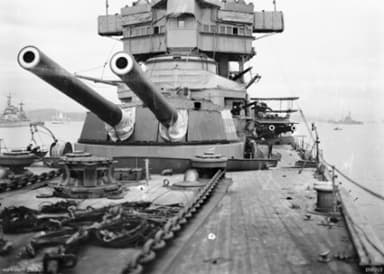
https://en.wikipedia.org/wiki/File:ATurretHMASAustralia1918.jpg
By December 1918 every battleship in the British Grand Fleet carried a two-seater aircraft on a platform mounted on a forward turret, and a single-seat fighter on a platform mounted on an after turret. Smaller cruisers had a single flying off platform, allowing aircraft greater influence over naval battles.
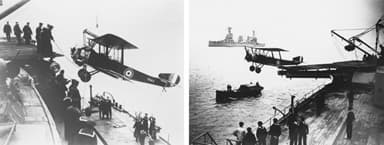
https://www.navy.gov.au/aircraft/sopwith-1%C2%BD-strutter
The specification of the Sopwith 1½ Strutter was as follows:
- Length 25 ft, height 10 ft, wing span 33.5 ft, wing area 346 sq ft
- Empty weight 1,305 lb, gross weight 2,149 lb, crew two
- Clerget 9B 9-cylinder air-cooled rotary piston engine, 130 hp
- Max speed 100 mph, endurance 3.5 hours, ceiling 15, 500 ft, 6,500 ft in 9 min
- One .303 inch forward-firing synchronised Vickers machine gun
- One .303 inch Lewis gun for observer, up to 130 lb bomb load
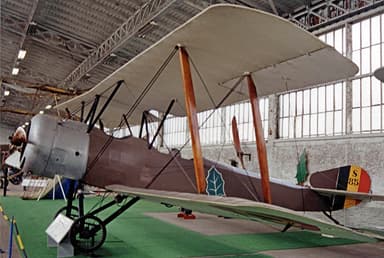
https://en.wikipedia.org/wiki/File:Sopwith_1_1.2_Strutter_S.85_BRU_Msm_14.04.00R_edited-2.jpg
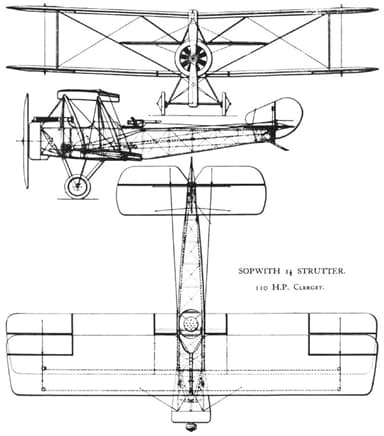
https://en.wikipedia.org/wiki/Sopwith_1%C2%BD_Strutter#/media/File:Sopwith_1%C2%BD_Strutter_drawing.jpg
United States Launches First Airmail Service (May 1918)
The United States Postmaster General authorized the issue of the nation’s first airmail stamp to the general public on May 13, 1918. The twenty-four cent stamp – expensive by today’s standards – depicted a Curtiss JN-4H Jenny going about its peaceful business.
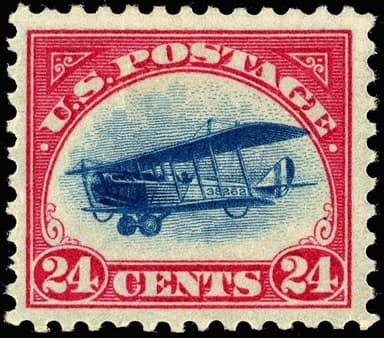
https://en.wikipedia.org/wiki/List_of_United_States_airmail_stamps#/media/File:US_stamp_1918_24c_Curtiss_Jenny_-C3.jpg
Postmaster General Albert S. Burleson assigned an additional duty to Second Assistant Postmaster General Otto Praeger on May 15 two days later. It was his duty, as first chief of the U.S. Airmail Service to ensure the airmail once started must not stop.
‘It must be constantly improved and expanded until it would become, like the steamship and the railroad, a permanent transportation feature of the postal service.’ Lieutenant Geoffrey Boyle from a team of six made America’s first delivery in a modified Curtiss JN-4H ‘Jenny’ biplane that same day.
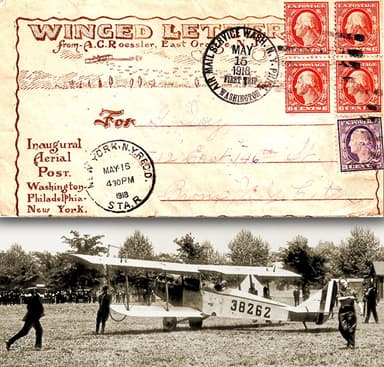
https://en.wikipedia.org/wiki/Airmails_of_the_United_States#/media/File:First_US_Air_Mail_Flight_1918.jpg
The specification of the Curtiss JN-4 Jenny was as follows:
- Length 27.5 ft, height 10 ft, wing span 43.5 ft, wing area 352 sq ft
- Empty weight 1,390 lb, gross weight 1,920 lb, crew two
- Curtiss OX-5 V-8 liquid-cooled piston engine, 90 hp
- Max speed 75 mph, cruise 60 mph, ceiling 6,500 ft, 2,000 ft in 7 min
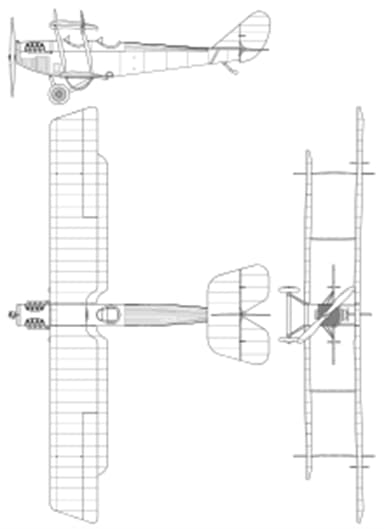
https://en.wikipedia.org/wiki/Curtiss_JN-4_Jenny#/media/File:Curtiss_JN-4B_Jenny.svg
Germany Experiments with Seagoing Aviation Ship (May 1918)
The converted light cruiser SMS Stuttgart was the sole German seagoing aviation ship capable of working with a fleet during either World War I, or World War II. She was something of an experiment for she never saw active service before scrapping after the first hostility ended.

https://forum.worldofwarships.eu/topic/2647-sms-stuttgart/
The conversion involved removing the forward and rear main guns, and adding two hangars astern of the third funnel. These provided storage for two seaplanes, with a third one lashed down atop. However, the admiralty deemed these insufficient and announced plans for a second aviation ship, which were subsequently abandoned.
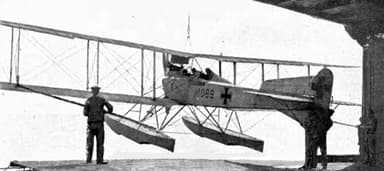
http://www.allworldwars.com/The-German-Air-Force-In-The-Great-War-by-Neumann.html
Germany Ceases Bombing Attacks on South England (May 1918)
Germany lost six giant bombers, with a seventh forced to the ground largely intact by British fighters, of the 41 it sent across the channel on the night of May 19, 1918. This was Germany’s last attack in a campaign that cost it 62 bombers in total for scant returns.

https://www.military-history.org/articles/strategic-bombing-gothas-over-london.htm
It had dropped a quarter million pound weight in bombs, but only succeeded in killing 835 people, injuring a further 1,972, and inflicting UK £1,418,272 damage. However, things might have been far more devastating, had it possessed accurate bomb sights and detailed maps as was the case in World War 2.
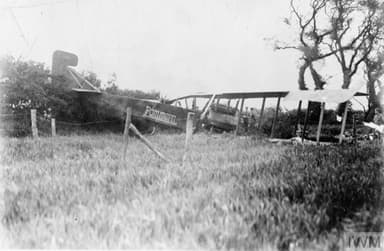
https://www.facebook.com/TheGreatWar191418/photos/21st-may-1918-downed-gotha-essexpictureda-gotha-gv-crashed-on-the-east-coast-aft/1279723618826553/
All-Metal, Stressed Skin Biplane the Armistice Killed (June 1918)
The Zeppelin D.1, alternatively Zeppelin-Lindau D.I or Zeppelin D.I (Do) was a single-seat all-metal stressed skin, monocoque, cantilever-wing biplane fighter with numerous advanced features. Claude Dornier developed it while working for Luftschiffbau Zeppelin at their Lindau facility. However, it was too late for operational service.
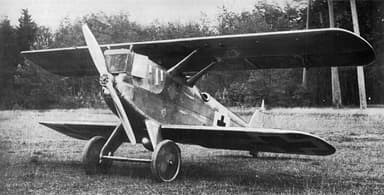
https://en.wikipedia.org/wiki/File:Zeppelin-Lindau_(Do)_D.I.jpg
This was the first fighter aircraft to benefit from the greater rigidity of an all-metal stressed skin monocoque structure. It first flew on June 4, 1918 where after it entered production. The construction method considerably reduced the risk of fires, and it also had an external fuel tank that may have been able to be jettisoned.
Seven prototypes were built for Luftstreitkräfte pilot evaluation in May, June and October 1918. The pilots reported heavy aileron controls, and poor climb performance at higher altitudes. However, the air force ordered 50 after substitution with a more powerful BMW IIIa inline-six liquid-cooled engine.
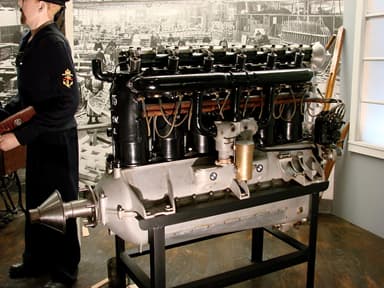
https://en.wikipedia.org/wiki/BMW_IIIa#/media/File:BMW_IIIa.jpg
The specification of the Zeppelin D.1 was as follows:
- Length 21 ft, height 8.5 ft, upper wing span 25.5 ft, wing area 210 sq ft
- Empty weight 1,598 lb, gross weight 1,951 lb, crew one
- BMW IIIa water-cooled 6-cylinder inline engine,185 hp
- Max speed 120 mph, ceiling 26,600 ft, 13 min to 16,000 ft
- Two 0.312 inch fixed forward-firing LMG 08/15 Spandau machine guns
First Official Canadian Airmail Delivery (June 1918)
The first scheduled Canadian airmail flight took off on June 24, 1918 from Montreal to Toronto. There may have earlier, private ones, and these continued in remote northern areas through the 1930’s.
The pilot was Captain Brian Peck, and his aircraft was a Curtiss JN-4 Canuck Jenny. Anecdotal history suggests the load was so heavy the aircraft could only ascend to 40 ft. It seems the pilot had added an illegal load of alcohol for a friend’s wedding during prohibition.

https://www.facebook.com/1greatvirtualeducationalexperience/posts/993318910726570:0
The Siemens-Schuckert D.III Biplane Fighter (April 1918)
The Siemens-Schuckert D.III was a German single-seater biplane that struggled to find a suitable engine in the closing months of World War 1. Its construction was sound with (almost) equal-span wings, and pilots were enthusiastic about the new aircraft’s handling and rate of climb.
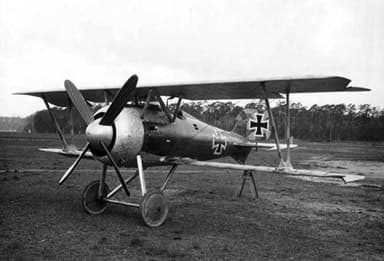
https://en.wikipedia.org/wiki/File:SSW_D.III.jpg
The German Siemens-Schuckert D.III was a derivation of the earlier Siemens-Schuckert D.IIc prototype. However, it used a Siemens-Halske Sh.III bi-rotary engine which proved to be its nemesis. After 41 aircraft were rushed into service in April and May 1918, serious problems developed with overheating and piston seizure.
The problem lay with the mineral cooling oil used to substitute for castor oil in short supply. In addition, the close-fitting engine cowl was obstructing air flow. Modifications included a revised Sh.IIIa engine, larger rudders and a cutaway cowl. However by the time the aircraft returned to service in July 1918, the Siemens-Schuckert D.IV had replaced it.
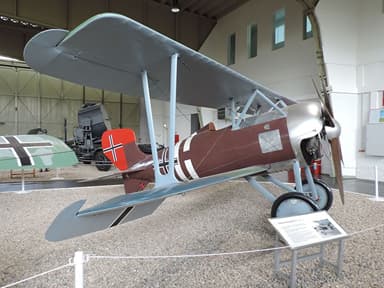
https://commons.wikimedia.org/wiki/File:Siemens-Schuckert_D_III_Gatow_DSCN7319_(2).jpg
The specification of the Siemens-Schuckert D III was as follows:
- Length 18.5 ft, height 9 ft, wingspan 27 ft, wing area 203 sq ft
- Empty weight 1,153 lb, gross weight 1,598 lb, crew one
- Siemens-Halske Sh.III / Sh.IIIa 11-cylinder rotary engine, 160 hp
- Max speed 110 mph, range 220 mi, ceiling 26,000 ft, 3,300 in 1.75 min
- Two 0.312 inch LMG 08/15 fixed, forward pointing machine-guns

https://en.wikipedia.org/wiki/Siemens-Schuckert_D.III#/media/File:Siemens-Schuckert_D.III_dwg.jpg
The Airco DH.9 / DH.9A Single Engine Biplane Bomber (July 1918)
The British Airco DH.9 was an evolution of the earlier, successful DH.4, with which it shared many components. These combined with an all-new fuselage and the BHP/Galloway Adriatic engine, which promised increased performance. However, on entering service the engine proved underpowered and unreliable.
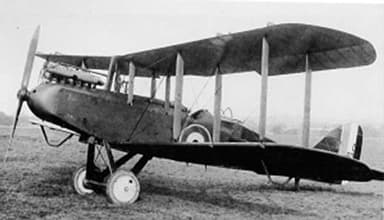
https://en.wikipedia.org/wiki/File:Airco_D.H.9.jpg
The Airco DH.9A that followed was a huge improvement with 1,997 eventually manufactured. It featured the American V-12 Liberty engine that delivered the power it needed. However, it still suffered high losses during long range bombing missions over Germany.
https://en.wikipedia.org/wiki/File:Airco_D.H.9A_ExCC.jpg
The specification of the Airco DH.9A was as follows;
- Length 30 ft, height 11.5 ft, wingspan 46 ft, wing area 487 sq ft
- Empty weight 2,800 lb, max weight 4,645 lb, crew two
- Liberty 12A water-cooled V-12 engine, 400 hp
- Max speed 123 mph, endurance 5.5 hr, ceiling 16,570 ft, 16 min to 10,000 ft
- One forward firing Vickers machine gun, two Lewis guns on Scarff ring
- Up to 740 lb bombs on underwings and fitted to fuselage racks

Link to Image
The Fokker E.V D.VIII Parasol Monoplane Fighter (August 1918)
The Fokker D.VIII entered service in August 1918 after first flying in May that year. It was the last Fokker design that reached operational status during World War I. Around 381 were produced, although a mere 85 reached the frontline before Armistice ended the conflict.
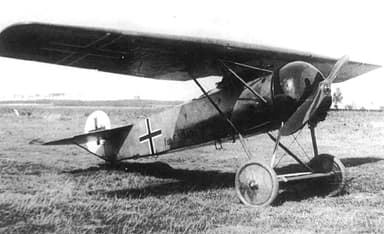
https://en.wikipedia.org/wiki/File:Fd8.jpg
Fokker produced several prototypes that year, with their characteristic steel-tube fuselages supporting overhead wings . But by then engines were in short supply, and only the underpowered Oberursel Ur.II engine was available in sufficient numbers. However, low drag and weight made up for this, and the military ordered 400 hoping more power would become available.
Two aircraft suffered collapsed wings within days of commissioning. Production halted while engineers suggested the wooden rear spar was weak, and twisted easily. This could have been resolved by over-reinforcing it. However, the root cause turned out to be shoddy and rushed construction under pressure to deliver. Systems were put in place and production continued.
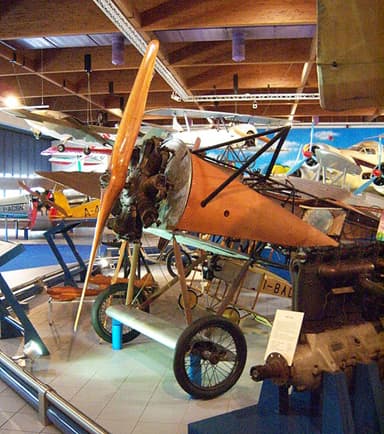
https://en.wikipedia.org/wiki/File:Fokker_D.VIII_fuselage_2009-06-02.JPG
The specification of the Fokker D.VIII was as follows:
- Length 19 ft, height 8.5 ft, wing span 27.5 ft, wing area 115 sq ft
- Empty weight 893 lb, gross weight 1,334 lb, crew one
- Oberursel UR.II 9-cyl. air-cooled rotary piston engine, 110 hp
- Max speed 127 mph, endurance 1.5 hrs, ceiling 20,000 ft, 3,200 ft in 2 min
- Two fixed forward firing 0.312 inch Spandau MG08 machine guns
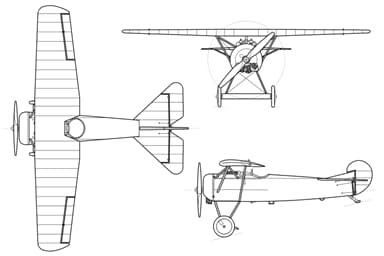
https://en.wikipedia.org/wiki/File:Fokker_D.VIII_3-view.svg
Siemens-Schuckert D.IV Biplane Fighter (October 1918)
The German Siemens-Schuckert D.IV was a conventional biplane that entered service in October 1918 as the last in line of the D.1, II and III versions. It might have lived up to expectations of becoming Germany’s most successful fighter, had the Armistice not intervened.

https://commons.wikimedia.org/wiki/File:Siemens-Schuckert_D.IV_-_Ray_Wagner_Collection_Image_(21439712675).jpg
The Siemens-Schuckert D.IV was a traditional-type biplane of largely wooden construction. However the port wing panels were three inches shorter outboard the struts, than the starboard ones. This was to counter the P-factor of its huge four-blade propeller.
The aircraft was generally easy to fly despite the short landing gear, and limited propeller clearance. Its top speed was an improvement over previous versions in terms of climb rate and top speed. In fact it was more maneuverable than the Mercedes-powered Fokker D.VIII with a winning climb rate.
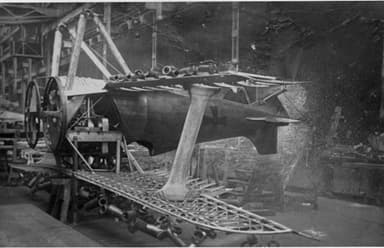
https://en.wikipedia.org/wiki/File:Siemens-Schuckert_D.II_-_Ray_Wagner_Collection_Image_(21439705645).jpg
The German military ordered 280 Siemens-Schuckert D.IV’s, of which only some 60 reached operational status before the Armistice. The climb rate was impressive with 20,000 feet in less than 16 minutes. However the peace treaty outlawed aircraft production. This was the end of the Siemens-Schuckertwerke airplane division.
The specification of the Siemens-Schuckert D.IV was as follows:
- Length 19 ft, height 9 ft, wing span 27.5 ft, wing area 163 sq ft
- Empty weight 1,190 lb, gross weight 1,620 lb, crew one
- Siemens-Halske Sh.III 11-cylinder air-cooled geared rotary engine 157 hp
- Max speed 120 mph, range 240 mi, endurance 2 hrs, ceiling 26,000 ft
- Climb rate 3,200 feet under two minutes, 20,000 feet under 16 minutes
- Weapons: two 0.31 inch forward facing LMG 08/15 machine guns
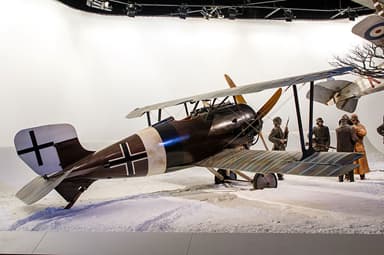
https://commons.wikimedia.org/wiki/File:NZ290315_Omaka_Siemens_Schuckert_01.jpg
The Airco DH.10 Amiens Twin Engine, Medium Bomber (Nov 1918)
The British Airco DH.10 Amiens bomber was designed and built during the final stages of World War 1, but continued in service briefly after Armistice. Designer Geoffrey de Havilland derived it from the earlier, failed Airco DH.3 bomber. The air force had rejected the latter in 1916, because it did not see a future in strategic bombing, and considered twin engines impractical.
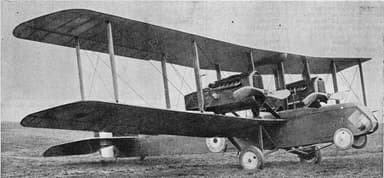
https://en.wikipedia.org/wiki/File:Airco_DH_10_ExCC.jpg
The final prototype – after several false starts – showed superior performance thanks to using American Liberty 12 engines, having relatively high speed, and boasting a competitive bomb load. Allied forces ordered a total 1,291 after successful evaluation.
However, the Amiens only completed a single bombing mission before the Armistice brought hostilities to an end. But it continued to serve in several post war roles, including supporting ground troops during the Third Anglo-Afghan war, and providing postal services between Cairo and Baghdad.
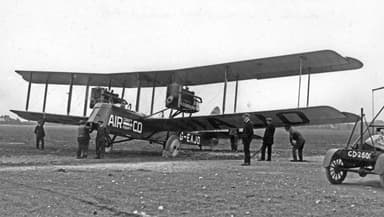
https://www.baesystems.com/en/heritage/airco-dh10-amiens
The specification of the Airco DH.10 Amiens was as follows:
- Length 39.5 ft, height 14.5 ft, wing span 65.5 ft, wing area 837 sq ft
- Empty weight 5,570 lb, gross weight 8,500 lb, crew three
- Two Liberty 12 water-cooled V-12 engines, 400 hp each
- Max speed 131 mph, 124 mph at 10,000 ft, endurance 6 hours
- Service ceiling 19,000 ft, time to 10,000 ft 11 minutes
- One or two .303 inch Lewis guns at both nose, and mid-ship cockpits
- Bomb load: Up to 920 lb bombs carried internally
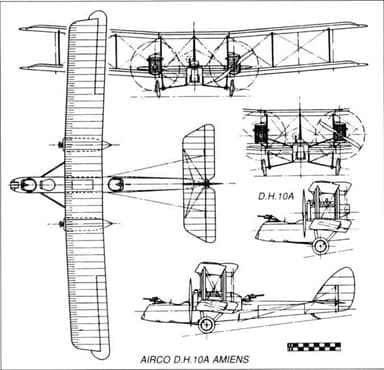
https://www.sas1946.com/main/index.php?topic=28330.12





